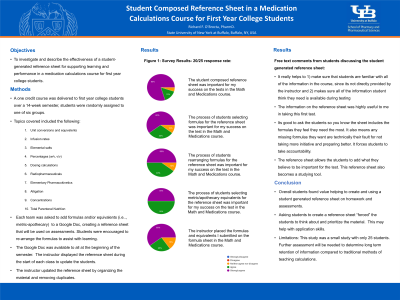Experiential Education
(306) Experience with a Student-Composed Reference Sheet in a Medication Calculations Course


Richard F. O'Brocta, PharmD.
Clinical Associate Professor
University at Buffalo, The State University of New York
Buffalo, New York, United States
Primary Author(s)
Objective : To investigate and describe the effectiveness of a student-generated reference sheet for supporting learning and performance in a medication calculations course for first year college students.
Methods: Students assigned to teams collaboratively built a reference sheet throughout the semester by adding formulas (ie, how to calculate milliequivalents) and comparing measuring scales (ie, avoirdupois cf. apothecary measures) in a shared Google Doc, this was done outside of class time. The instructor organized the material weekly and made it available during class meetings to make sure all students were made aware of updates. An anonymous online survey assessed student perceptions of the reference sheet's value after its use in assessments.
Results: A total of 20 of 25 (80%) students responded to the anonymous on-line survey. Key findings of this study are as follows: (1) 60% strongly agreed that contributing formulas to the reference sheet was important for their success, (2) 50% strongly agreed that students re-arranging the formulas for the Google Doc was helpful to their learning, and (3) 84% (21/25) achieved grades of A or B; the remaining students received C's.
Conclusions: A student-created reference sheet appears to benefit exam performance in a medication calculations course. Further research is needed to assess long-term learning retention compared to traditional approaches.
Methods: Students assigned to teams collaboratively built a reference sheet throughout the semester by adding formulas (ie, how to calculate milliequivalents) and comparing measuring scales (ie, avoirdupois cf. apothecary measures) in a shared Google Doc, this was done outside of class time. The instructor organized the material weekly and made it available during class meetings to make sure all students were made aware of updates. An anonymous online survey assessed student perceptions of the reference sheet's value after its use in assessments.
Results: A total of 20 of 25 (80%) students responded to the anonymous on-line survey. Key findings of this study are as follows: (1) 60% strongly agreed that contributing formulas to the reference sheet was important for their success, (2) 50% strongly agreed that students re-arranging the formulas for the Google Doc was helpful to their learning, and (3) 84% (21/25) achieved grades of A or B; the remaining students received C's.
Conclusions: A student-created reference sheet appears to benefit exam performance in a medication calculations course. Further research is needed to assess long-term learning retention compared to traditional approaches.

.png)